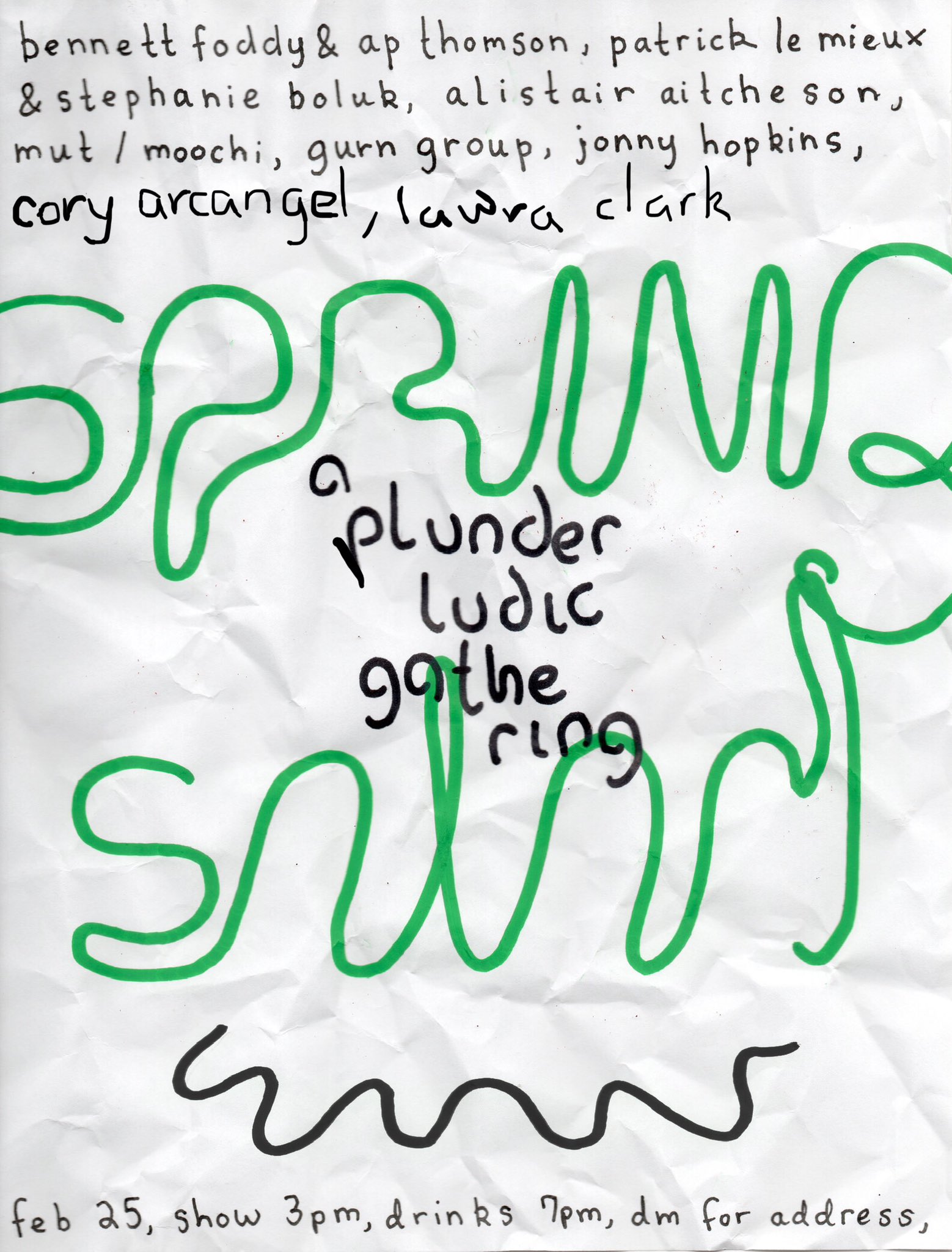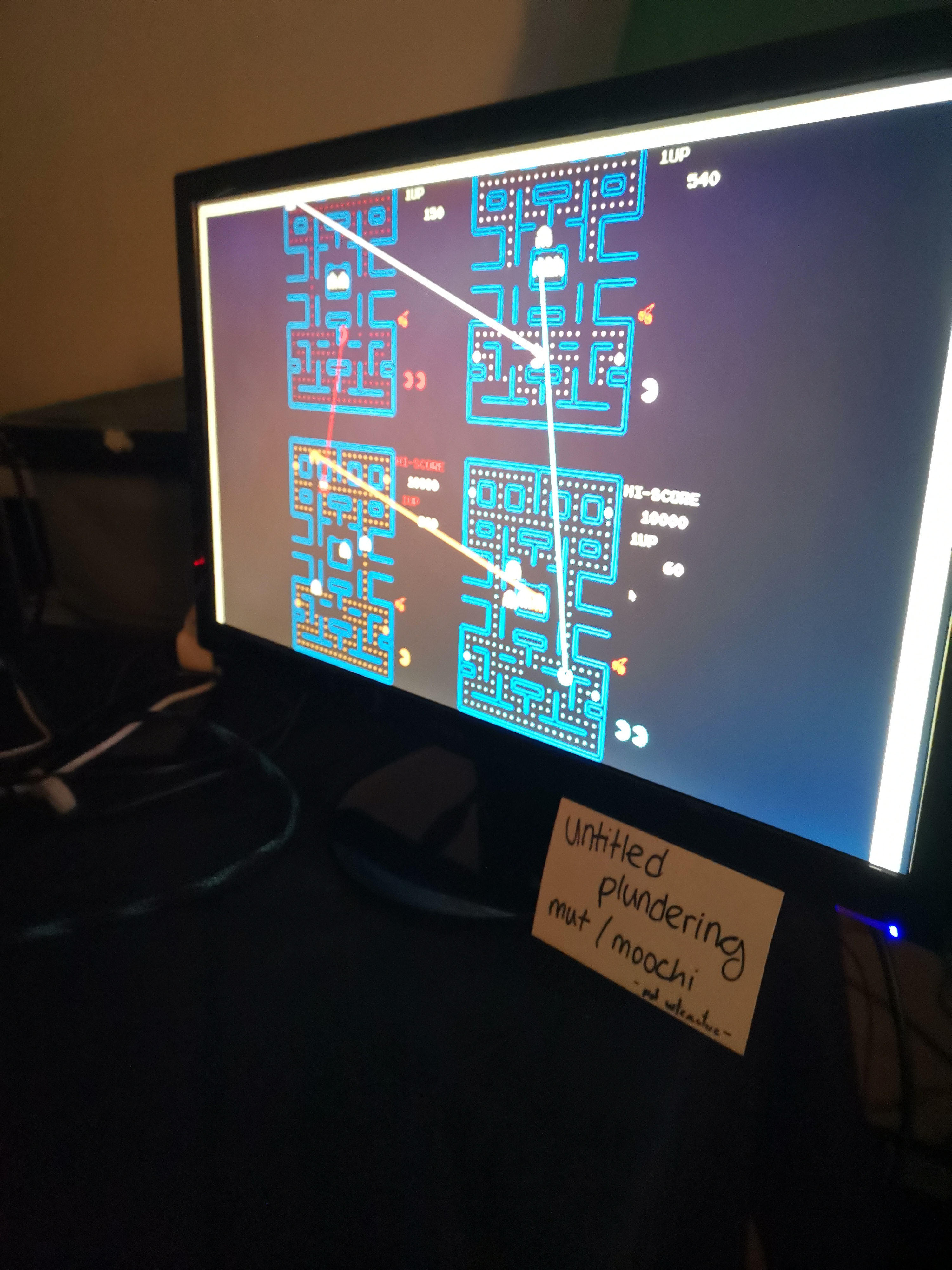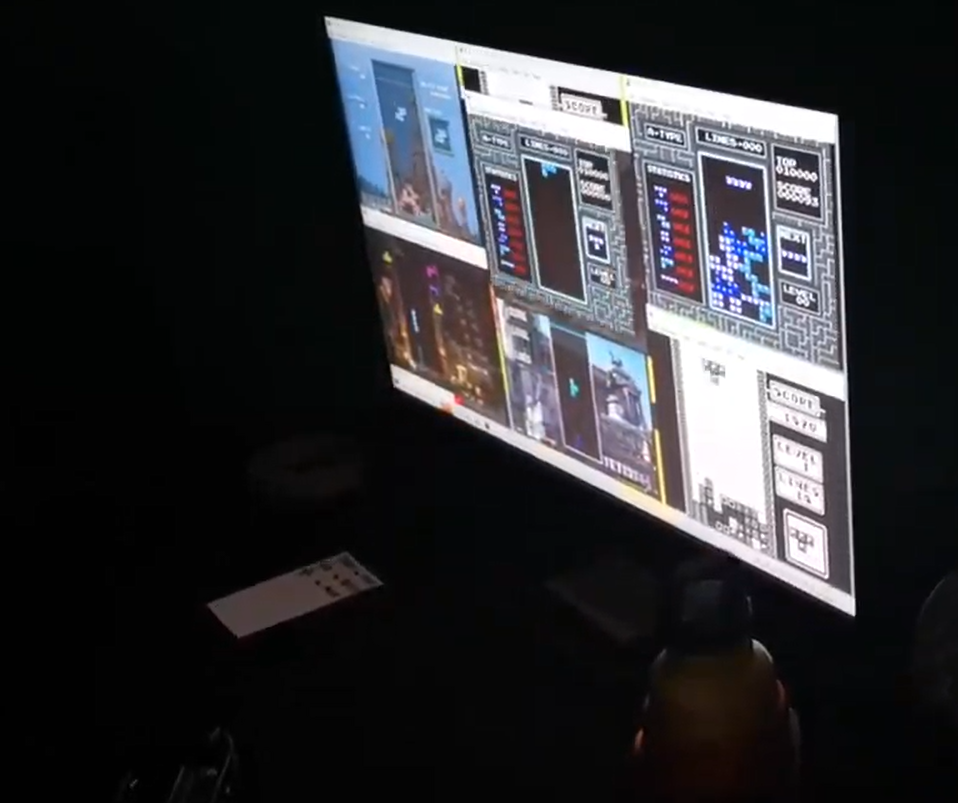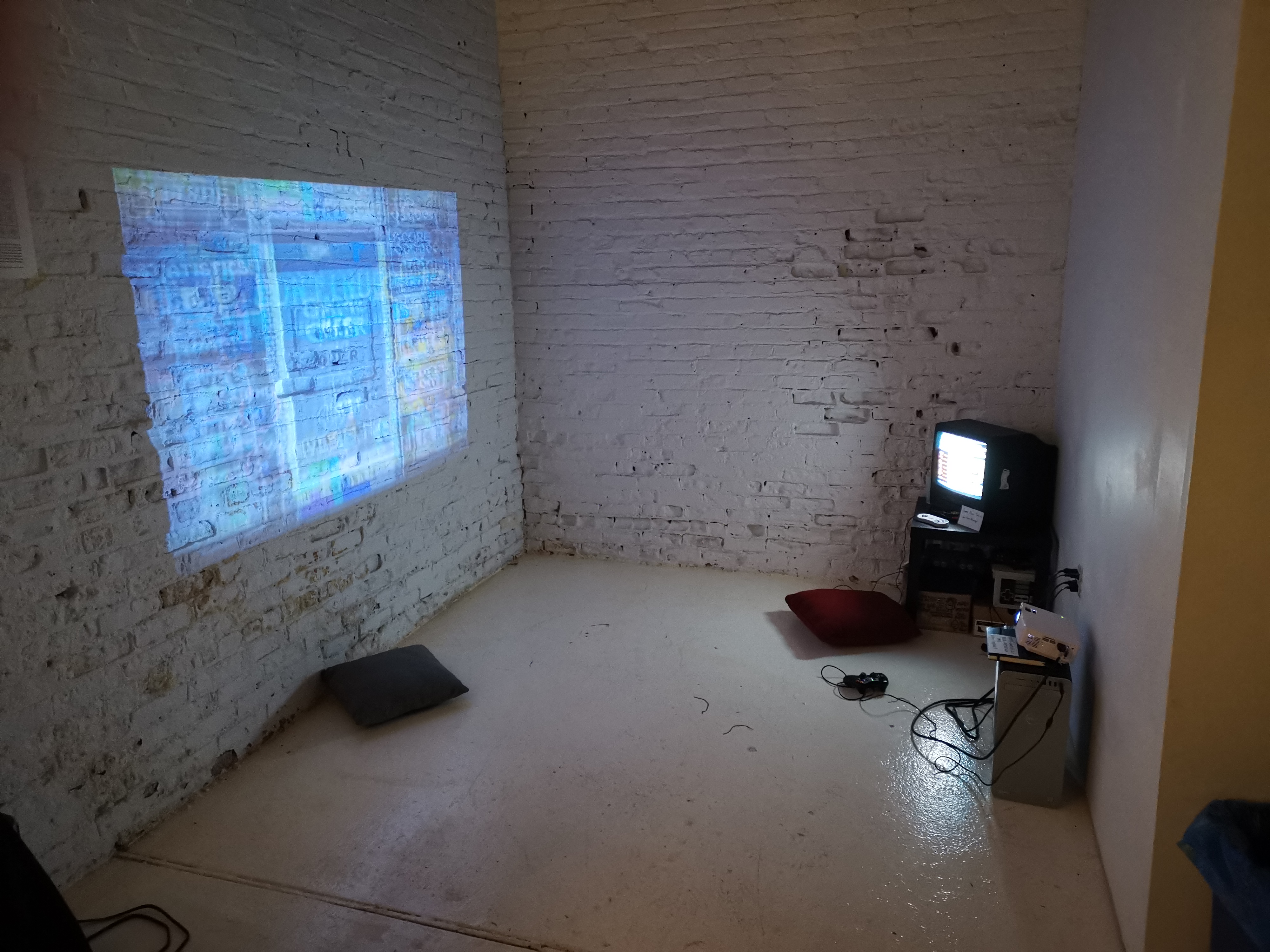2023-02-25 spring salad
works:
tapestry
Tetris, but all at once
Tetris, but all at once, but all at once
auto mario
pacman quine
feztris
pl1
pl2
pl3
Magic Box
99 exercises in play
super slow tetris
multibowl
three skeletons

we showed some of our work accompanied by some of the many references.
going clockwise in the space where the games where shown:
Left: BizHawk Ring Shuffler, Alistair Aitcheson
Right: Multibowl, Bennett Foddy & AP Thomson
on the projector there was AP Thompson and Bennett Foddy's Multibowl side by side with Alistair Aitcheson's Magic Box, both collections of multiple unmodified videogames, randomly swapped within some ludic structure ran: Multibowl with timed wario-ware style minigames, Magic Box with certain in-game events (collection of rings in sonic being the prominent one) causing the swap.
Auto Mario, mut moochi
on a cellphone attached to a canvas on the corner of the room was Auto Mario, a game where players have the opportunity to play with the attract screen of an unmodified version of Super Mario Bros for the NES. by editing a specific address in memory that causes Mario to toggle between its dead and alive animation, players can try getting Mario further along the level given the series of inputs nintendo predetermined for the attract mode animation.
pl 1, pl 2, pl 3, Gurn Group
on three screens attached to the wall were GURN GROUP's pl 1, pl 2 and pl 3. these works are playable (with the analog stick and one button) visual compositions made from compositing multiple unmodified games running at the same time, creating a textural collage of videogames. on plunder 1, centered, was a composition of a character select from WWE whose face would change with input and the model would rotate, a level from Command and Conquer with the background keyed out in which you could select and move the character around, all on top of a barn scene from Boku No Natsuyasumi, in which you could move the character around the barn. on plunder 2 a minimap from populous 2 was laid out on top of a composition of Silent Hill's snow and mountany villa with Gran Turismo pine tree forest, the input would move the view along the map, while also rotating the trees and snowy background. finally plunder 3, which i don't really know how to explain, its like this game that has this intense shock braind effect, with this square that creates a weird zone (lets hope gurn edits this later)...

Tapestry, mut moochi
on the next table was the interactive game by mut/moochi tapestry #4, in which you walk (or swim or glide) around multiple unmodified n64 and psx third person platformers games as they blend between one another, three showing up at a time, as they come and go, from mario to zelda, to croc and bugs bunny. a spatial and temporal collage rather than a composition or game structure.

Untitled plundering, mut moochi
next to tapestry, also by mut/moochi was an untitled plundering, a pacman "quine", a non interactive piece where four instances of pacman play themselves, one ghost from each of the games controlling pacman of the next one.

in the corner on a desk was Tetris, but all at once, a playable tetris plunder where clearing a line on an emulated Tetris ROM would tile another simultaneous tetris ROM on the screen, until one of the games is lost.
Three Skeletons, Lawra Clark
on a wooden saw horse bracket were three PSPs displaying Lawra Suits Clark's "Three Skeletons", a self-running endless loop of Tactics Ogre: Let Us Cling Together.
Feztris, mut moochi
on the ground, another piece by mut/moochi, "untitled tetris plunder" (Feztris) in which three instances of tetris for the nes run simultaneously, each game being a 2d projection of a 3d structure that is being build by the blocks as they stack.
99 Exercises in Play, Stephanie Boluk & Patrick LeMieux
on a desk was 99 exercises in play by Patrick Lemieux and Stephanie Boluk, a series of experiments conducted on a recreation of the first level of Super Mario Bros for the NES.

Left: Tetris, but all at once, but all at once, Jonny Hopkins
Right: Super Slow Tetris, Cory Arcangel
together sharing a corner of the space were Cory Arcangel's Super Slow Tetris, a very slow-progressing ROMhack of NES Tetris installed on a small CRT, and Tetris, but all at once, but all at once, a blending of 8 different simultaneous different Tetris games, projected onto a wall.
bennett foddy wrote
it was nice to see all the different things! I guess the main thing it makes me think about is the various different roles the emulated games play in these pieces - how it feels different in Patrick's '99 exercises' for it not to be emulated.
In Jonny's tetris games, it is really important that it is an recognizable game, and I think also important that it is tetris in particular. Part of it is that it's reframing something that the player already knows how to do in a deep way as something that is hard or impossible... it sets up a metaphor for feeling overwhelmed in life, that there are tasks that would be easy if taken alone that become impossible taken as a set. Similarly in that Arcangel Tetris piece, it's important that everyone who sits down with it has an opinion about how it ought to be played - so there can be collaborative play, discussion and disagreement and so on. In these cases it's important that it looks like historic versions of tetris, and plays like tetris, but maybe it's not important that it's emulated?
In your 'toggle death' mario game, it is important that it is emulated in particular, but not really important that the game is Mario or even that it's recognized by the player. It's playing with the idea of an attract mode, which is a fated loop that the character cannot escape, but you're breaking the rules and allowing him to escape death. 'Breaking the Rules' is an idea that only works because it's an emulated or hacked version of a 'real', released game. If you had access to the actual source code, it would be nothing.
The game where you push on the walls to fade between platformers... I think in that case it's important that the games are 'real', but maybe less important that they are emulated. I think I said to you last night, the crossfade suggests the cinematic cliche of someone remembering something. So it feels like the player is thinking 'oh this is like that other time....'. I wish it wasn't walking into walls, but something that was more of a key moment in actual games the player had played? Because walking into walls is not really something memorable. But I loved the feeling of the crossfade.
In multibowl I think it is important that it is running on an emulator, even though 99% of the games are unfamiliar to the players - so I'm not using the emulated games to establish familiarity or memory or literacy or anything like that. I've played games with a similar set of ideas that were all original (some NYU students including Ben Sironko made a game called 'Tuned Out' as their thesis which does this) and it still works, but i think there is a pretty big difference of feeling between 'I've made a new situation and put you in it' and 'I'm putting you in this situation that exists'.
So, I haven't really thought it through but the ideas are something like
- familiar games (emulated or unemulated) for literacy/nostalgia/conveying meaning
- emulation being the arbiter of strict 'rules' or 'facts' about a game
- emulated, familiar games being 'true memories'
- emulated, unfamiliar games being 'true experiences'
There are related ideas in other media. The one that comes to mind is Portishead's second album - I think having been burned by the cost of 'clearing' samples on their first record (which means, paying a licensing fee) they claimed - I have no idea if true or false, but sounds false - that they recorded a whole jazz record first, pressed it to vinyl, then used that as the source of samples and scratching for the final record. Although convenient for copyright reasons, I feel like collage constructed of work made by the collage-maker is missing something of the value in collage or any postmodernist form... it's 'hermetic', enclosed in itself, antisocial. One of the big reasons that sampling and collage and intertextualism are interesting and vital forms, is that there are multiple voices playing together."